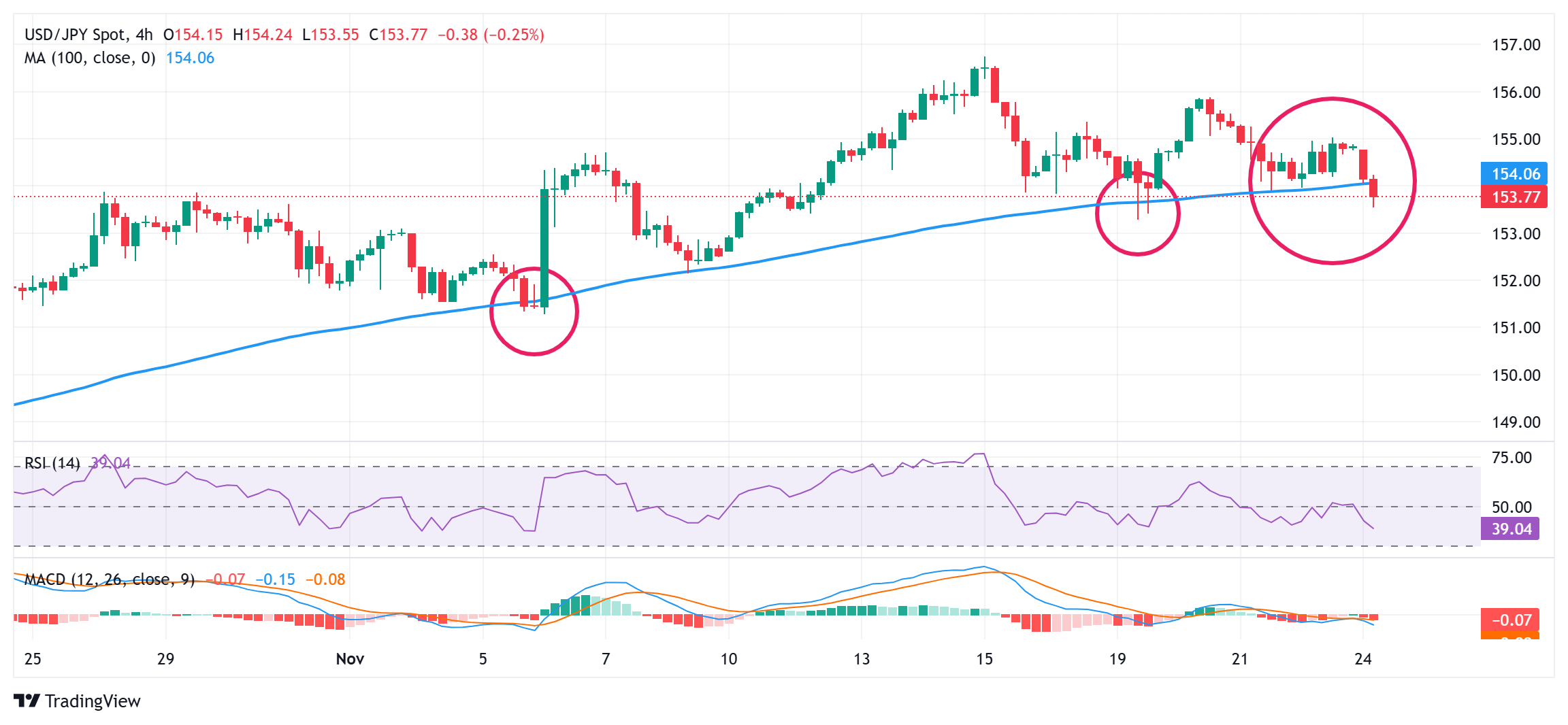- The Japanese Yen jumps back closer to last week’s swing high against its American counterpart.
- Retreating US bond yields prompts some USD profit-taking and benefits the lower-yielding JPY.
- The BoJ uncertainty and the risk-on mood might cap any further gains for the safe-haven JPY.
The Japanese Yen (JPY) strengthens against its American counterpart at the start of a new week, dragging the USD/JPY pair back below the 154.00 mark during the Asian session. The US Treasury bond yields fell sharply in reaction to Scott Bessent’s nomination as US Treasury Secretary. This, in turn, prompts traders to lighten their US Dollar (USD) bullish bets after the recent rally to a two-year high and drives some flows towards the lower-yielding JPY.
That said, the uncertainty tied to the Bank of Japan’s (BoJ) rate-hike plans, along with the prevalent risk-on environment, could cap any meaningful appreciating move for the safe-haven JPY. Moreover, expectations that US President-elect Donald Trump’s policies could reignite inflation and restrict the Federal Reserve (Fed) to cut interest rates slowly might act as a tailwind for the US bond yields. This, in turn, favors the USD bulls and should offer support to the USD/JPY pair.
Japanese Yen benefits from retreating US bond yields and a weaker US Dollar
- US President-elect Donald Trump nominated prominent investor Scott Bessent – a fiscal conservative – as Treasury Secretary, reassuring the bond market and pulling yields lower across the board.
- The US Dollar, having risen for eight weeks in a row, retreats from its highest level since November 2022 as traders opt to take some profits off the table following the post-US election blowout rally.
- Despite stronger consumer inflation data from Japan and Bank of Japan Governor Kazuo Ueda’s hawkish remarks, domestic political uncertainty could restrict the BoJ from tightening its monetary policy.
- Meanwhile, investors have been scaling back their bets for another 25-basis-points rate cut by the Federal Reserve in December amid worries that Trump’s policies could boost inflationary pressures.
- According to CME Group’s FedWatch Tool, traders are pricing in just over a 55% probability that the Fed will lower borrowing costs next month and a nearly 45% chance for an on-hold decision.
- The optimism over more business-friendly policies from the new Trump administration was reinforced by the flash US PMIs, showing that business activity climbed to a 31-month high in November.
- S&P Global reported on Friday that the Composite US PMI rose to 55.3 this month, or the highest level since April 2022, suggesting that economic growth probably accelerated in the fourth quarter.
- Reports suggest that a ceasefire deal between Israel and the Lebanese militant group Hezbollah is very close, which further fuels the risk-on mood and might cap the upside for the safe-haven JPY.
- The focus this week will be squarely on the US Personal Consumption and Expenditure (PCE) Price Index data, which could offer cues on the Fed’s interest rate path and provide a fresh impetus.
USD/JPY finds acceptance below 100-period SMA on 4-hour chart; seems vulnerable
From a technical perspective, acceptance below the 100-period Simple Moving Average (SMA) now seems to have set the stage for a further depreciating move for the USD/JPY pair. That said, any further slide might continue to find some support near the 153.30-153.25 region. This is followed by the 153.00 round figure, which if broken decisively will be seen as a fresh trigger for bearish traders and pave the way for deeper losses. Spot prices might then accelerate the fall towards the next relevant support near mid-152.00s en route to the very important 200-day SMA, currently pegged near the 152.00 mark.
On the flip side, the 154.00 round figure now seems to act as an immediate hurdle ahead of the Asian session top, around the 154.40 region. Some follow-through buying should allow the USD/JPY pair to reclaim the 155.00 psychological mark and climb further towards the 155.40-155.50 supply zone. A sustained strength beyond the latter should pave the way for a move beyond the 156.00 mark, towards retesting the multi-month top, around the 156.75 region touched on November 15.
Japanese Yen FAQs
The Japanese Yen (JPY) is one of the world’s most traded currencies. Its value is broadly determined by the performance of the Japanese economy, but more specifically by the Bank of Japan’s policy, the differential between Japanese and US bond yields, or risk sentiment among traders, among other factors.
One of the Bank of Japan’s mandates is currency control, so its moves are key for the Yen. The BoJ has directly intervened in currency markets sometimes, generally to lower the value of the Yen, although it refrains from doing it often due to political concerns of its main trading partners. The BoJ ultra-loose monetary policy between 2013 and 2024 caused the Yen to depreciate against its main currency peers due to an increasing policy divergence between the Bank of Japan and other main central banks. More recently, the gradually unwinding of this ultra-loose policy has given some support to the Yen.
Over the last decade, the BoJ’s stance of sticking to ultra-loose monetary policy has led to a widening policy divergence with other central banks, particularly with the US Federal Reserve. This supported a widening of the differential between the 10-year US and Japanese bonds, which favored the US Dollar against the Japanese Yen. The BoJ decision in 2024 to gradually abandon the ultra-loose policy, coupled with interest-rate cuts in other major central banks, is narrowing this differential.
The Japanese Yen is often seen as a safe-haven investment. This means that in times of market stress, investors are more likely to put their money in the Japanese currency due to its supposed reliability and stability. Turbulent times are likely to strengthen the Yen’s value against other currencies seen as more risky to invest in.

